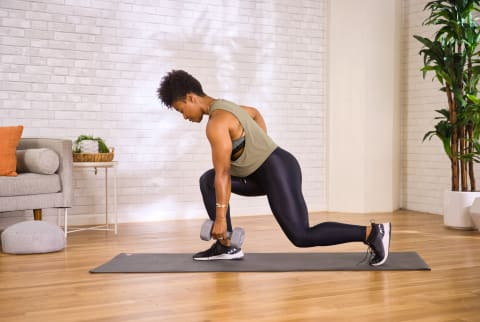Advertisement
This ad is displayed using third party content and we do not control its accessibility features.

Image by Andreas von Scheele / mbg
September 12, 2024
Working your legs and glutes is so important for a strong foundation in any fitness routine. If you’re looking for a simple but effective lower-body move that’s sure to get your muscles working, you’ll want to try reverse lunges.
(Bonus points: This move is gentler on your joints and safer for beginners than classic lunges.) Here’s how to do them properly, plus tips, modifications, and benefits, from certified personal trainer BB Arrington, CPT.
How to do reverse lunges:
- Grab a weight (optional), and start in a standing position. Step your left leg a bit behind you. Hold your weight in your left hand.
- Hinge at your hips, reach your back leg behind you, and bend your knees to lower down. Hold for 3 seconds, then come back up to start.
- That’s one rep.
Tips & modifications:
- If you’re new to this move and still building your strength, you can omit the weight and keep your hands on your hips instead, to make it easier.
- Arrington recommends keeping your hips square to ensure you’re targeting your muscles properly.
- Engage your core up and in for the entirety of the exercise.
- To incorporate your breath, exhale as you step back and lower your knee, and inhale on the way back up.
What are the benefits?
Compared to a classic forward lunge that makes your quads do more of the work, the reverse lunge tends to challenge your glutes a little extra. As Arrington explains, “In a reverse lunge, we get a good stretch in the glutes, though your quads and your hamstrings are helping you as well.” And spoiler alert: You’re definitely going to feel the burn.
What’s more, this variation on a classic lunge puts a lot less strain on your joints—which is perfect if you have any knee issues. (If you can relate, check out these five cardio workouts that are gentle on your knees.)
On top of that, with the addition of weights and core engagement, this can be considered a full-body move as it will target your arms and abs, too. And because you’re stepping back with one foot, it does require a bit of balance.
The next time you step into the gym—or work out from home—consider giving reverse lunges a try on leg day, or in a full-body workout. For a move so simple, you’re sure to feel the strength gains.

